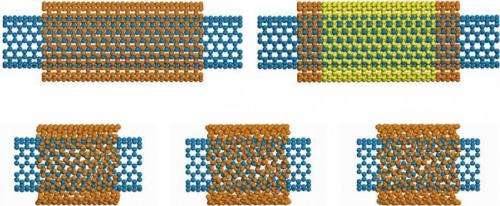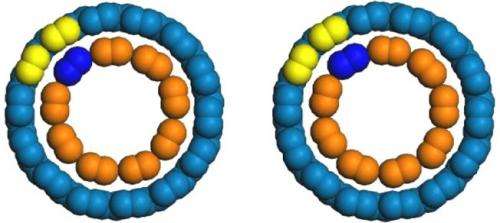December 8, 2014 feature
Rotating nanotube motors offer glimpse of future nanodevices

As one of the simplest and tiniest of all motors, a double-walled carbon nanotube (DWCNT) with a rotating inner tube and fixed outer tube may one day play a major role in a variety of future nanodevices. In a new study, researchers have studied the inner tube rotational behavior of a DWCNT motor whose motion is induced by a relatively high uniform temperature.
The researchers, K. Cai, et al., at Northwest A&F University in Yangling, China, and the Australian National University in Acton, Australia, have published their paper on DWCNT rotating motors in a recent issue of Nanotechnology.
As the scientists explain, DWCNTs have the potential to act as effective motors because of their combination of two important properties: the large strength of each individual tube due to its strong covalent bonds, and the weak interaction between the two adjacent tubes due to repulsive van der Waals interactions.
As previous research has shown, the inner tube can move inside the outer tube by either rotational or translational motion (moving forward and backward). Often, these two types of motion are combined so that the tube follows a helical orbit. The inner tube's specific track of motion is determined by its atomic interaction with the outer tube. Previous studies have revealed various motion-related phenomena of DWCNTs at the nanoscale, such as vanishingly small friction and a driving force that is proportional to temperature gradients.

In the new study, the researchers have shown in simulations that rotation in a DWCNT motor can be induced by a gradientless, uniform temperature. At approximately room temperature (300 K), the inner tube loses its geometric symmetry, causing it to rotate. The researchers investigated three factors that influence the rotation of the inner tubes: the environmental temperature, the length of the fixed portion of the outer tube, and the intertube gap.
Using molecular dynamics simulations, the researchers found that the inner tube's rotational frequency increases at a temperature of 300 K compared to lower temperatures, as the inner tube gains higher kinetic energy. Rotational frequency also increases when the full length of the outer tube is fixed because this creates higher torque on the inner tube. And finally, rotational frequency increases when the intertube gap is near a critical distance between two graphene sheets, in this case 0.335 nm. When the gap is smaller than this, the intertube friction increases, and when the gap is larger, there is weaker interaction between the tubes that decreases rotational motion.
With further work, a gradientless, temperature-driven rotating motor made of a DWCNT could have wide applications in the next generation of nanoelectromechanical systems (NEMS).
"Compared with any other nanomotor, e.g., electric motors and fluidic gas-driven motors, thermal DWCNT motors are simpler, smaller and easier to operate," Cai told Phys.org. "In particular, the rotational frequency of the inner tube is wide, which could be used for message transfer in electromagnetic nanodevices, such as switches, memories, etc."
In the future, the researchers plan to make further improvements to the motor.
"A robust DWCNT motor should be designed," Cai said. "For example, the nanostructure should be stable, the rotational state should be adjustable with high accuracy and with the measurement of the local electromagnetic field."
More information: K. Cai, et al. "Gradientless temperature-driven rotating motor from a double-walled carbon nanotube." Nanotechnology. DOI: 10.1088/0957-4484/25/50/505701
Journal information: Nanotechnology
© 2014 Phys.org
















